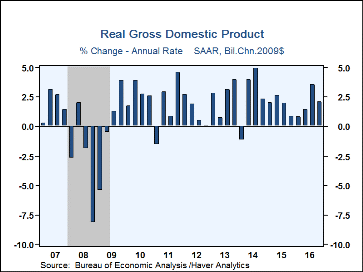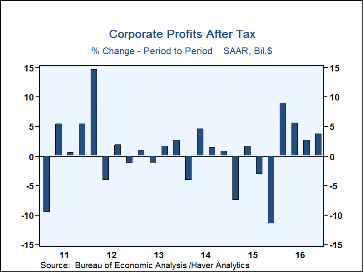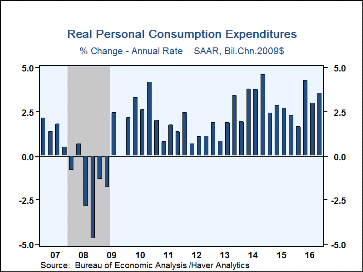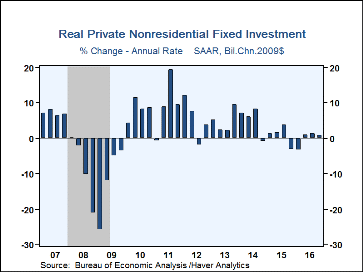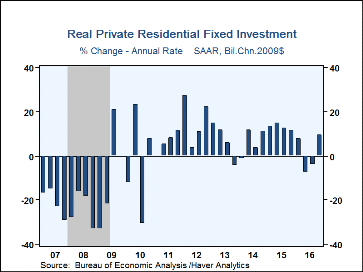 Global| Mar 30 2017
Global| Mar 30 2017U.S. GDP Growth Is Revised Higher; Corporate Profits Strengthen
by:Tom Moeller
|in:Economy in Brief
Summary
Economic growth during Q4'16 was revised up. Gross domestic product advanced 2.1% following two earlier estimates of 1.9% growth. During all of last year, growth decelerated to 1.6% from 2.6% in 2015. The Q4 figure compared to [...]
Economic growth during Q4'16 was revised up. Gross domestic product advanced 2.1% following two earlier estimates of 1.9% growth. During all of last year, growth decelerated to 1.6% from 2.6% in 2015. The Q4 figure compared to expectations for a 2.0% rise in the Action Economics Forecast Survey.
After-tax corporate profits increased 3.7% (22.2% y/y) after a 2.6% rise. Before tax profits with IVA & CCA gained 9.3% y/y. Earnings amongst domestic nonfinancial firms increased 3.0% y/y while financial company profits rose 21.0% y/y. Foreign sector profits rose 14.5% y/y.
As estimated last month, deterioration in the foreign trade deficit subtracted 1.7 percentage points from growth as exports fell 4.5% (+1.5% y/y) and imports increased 8.9% (2.6% y/y). Exports of goods fell 6.7% (+2.1% y/y), and services exports eased 0.1% (+0.4% y/y). Imports of goods strengthened 10.9% (2.4% y/y) while services imports gained 0.6% (3.4% y/y). The subtraction from GDP growth due to foreign trade followed three consecutive quarters of addition.
A 1.0 percentage point addition to GDP growth due to strengthened inventory accumulation offset much of the subtraction from foreign trade. It remained only the second quarterly addition since the beginning of 2015.
Growth in domestic final demand was revised up to 2.8% from 2.6%. It was the swiftest growth since Q3'15.
Personal consumption expenditures growth was revised to 3.5% from 3.0%. Spending on durable goods rose a little-changed 11.4% (7.9% y/y). Recreational goods & vehicles purchases jumped 14.3% (11.3% y/y) while motor vehicle & parts buying grew 16.3% (8.6% y/y). Furniture purchases rose 4.3% (6.1% y/y). In the nondurable goods sector, spending rebounded an upwardly revised 3.3% (2.6% y/y) after a 0.5% slip. The revision reflected a 1.6% decline (+0.3% y/y) in gasoline & oil purchases, revised from -5.9%. A 6.7% increase (4.9% y/y) in food store sales was accompanied by no change (+0.8% y/y) in apparel sales. Growth in spending on services also was revised up to 2.4% (2.5% y/y). Spending on recreation services increased 5.8% (0.9% y/y), revised from 1.8%.
Business fixed investment grew 0.9%, revised down from 1.3%. Structures spending declined a lessened 1.9% (+1.9% y/y), but the gain in equipment investment was little changed at 2.0% (-3.8% y/y). The rise followed four straight quarters of decline. Investment in intellectual property products rose 1.3% (4.3% y/y), revised from 4.5%. Industrial equipment investment increased 4.8% (1.8% y/y), revised from 1.9%, and information processing equipment investment improved an unrevised 4.2% (1.2% y/y).
Residential investment jumped at an unrevised 9.6% rate (1.1% y/y) following two quarters of decline.
Government spending increased a little-changed 0.2% (0.2% y/y). The gain was held back by a 1.2% decline (-0.2% y/y) in federal government purchases, reduced by a 3.6% shortfall (-2.0% y/y) in defense spending. State & local government purchases increased 1.0% (0.4% y/y) following two quarters of decline.
On the inflation front, the GDP chain price index increased a little-changed 2.1%. The PCE price index rose 2.0%, but less food & energy the gain was 1.3%, the weakest rise in four quarters. The business fixed investment price index rose 0.9% (0.6% y/y) while the residential price index gained a steady 5.3% (4.5% y/y).
The GDP figures can be found in Haver's USECON and USNA database. USNA contains virtually all of the Bureau of Economic Analysis' detail in the national accounts, including the integrated economic accounts and the recently added GDP data for U.S. Territories. The Action Economics consensus estimates can be found in AS1REPNA.
The 2017 Long-Term Budget Outlook from the Congressional Budget Office can be found here.
| Chained 2009 $ (%, AR) | Q4'16 (3rd Estimate) | Q4'16 (2nd Estimate) | Q4'16 (Advance Estimate) | Q3'16 | Q2'16 | Q4'16 Y/Y | 2016 | 2015 | 2014 |
|---|---|---|---|---|---|---|---|---|---|
| Gross Domestic Product | 2.1 | 1.9 | 1.9 | 3.5 | 1.4 | 2.0 | 1.6 | 2.6 | 2.4 |
| Inventory Effect | 1.0 | 1.0 | 1.0 | 0.5 | -1.2 | 0.0 | -0.4 | 0.2 | 0.0 |
| Final Sales | 1.1 | 0.9 | 0.9 | 3.0 | 2.6 | 2.0 | 2.0 | 2.4 | 2.5 |
| Foreign Trade Effect | -1.7 | -1.7 | -1.7 | 0.9 | 0.2 | -0.2 | -0.1 | -0.7 | -0.1 |
| Domestic Final Sales | 2.8 | 2.6 | 2.5 | 2.1 | 2.4 | 2.1 | 2.1 | 3.1 | 2.6 |
| Demand Components | |||||||||
| Personal Consumption Expenditures | 3.5 | 3.0 | 2.5 | 3.0 | 4.3 | 3.1 | 2.7 | 3.2 | 2.9 |
| Business Fixed Investment | 0.9 | 1.3 | 2.4 | 1.4 | 1.0 | -0.1 | -0.4 | 2.1 | 6.0 |
| Residential Investment | 9.6 | 9.6 | 10.2 | -4.1 | -7.8 | 1.1 | 4.9 | 11.7 | 3.5 |
| Government Spending | 0.2 | 0.3 | 1.2 | 0.8 | -1.7 | 0.2 | 0.9 | 1.8 | -0.9 |
| Chain-Type Price Index | |||||||||
| GDP | 2.1 | 2.0 | 2.1 | 1.4 | 2.3 | 1.6 | 1.3 | 1.1 | 1.8 |
| Personal Consumption Expenditures | 2.0 | 1.9 | 2.2 | 1.5 | 2.0 | 1.4 | 1.1 | 0.3 | 1.5 |
| Less Food/Energy | 1.3 | 1.2 | 1.3 | 1.7 | 1.8 | 1.7 | 1.7 | 1.4 | 1.6 |
Tom Moeller
AuthorMore in Author Profile »Prior to joining Haver Analytics in 2000, Mr. Moeller worked as the Economist at Chancellor Capital Management from 1985 to 1999. There, he developed comprehensive economic forecasts and interpreted economic data for equity and fixed income portfolio managers. Also at Chancellor, Mr. Moeller worked as an equity analyst and was responsible for researching and rating companies in the economically sensitive automobile and housing industries for investment in Chancellor’s equity portfolio. Prior to joining Chancellor, Mr. Moeller was an Economist at Citibank from 1979 to 1984. He also analyzed pricing behavior in the metals industry for the Council on Wage and Price Stability in Washington, D.C. In 1999, Mr. Moeller received the award for most accurate forecast from the Forecasters' Club of New York. From 1990 to 1992 he was President of the New York Association for Business Economists. Mr. Moeller earned an M.B.A. in Finance from Fordham University, where he graduated in 1987. He holds a Bachelor of Arts in Economics from George Washington University.


